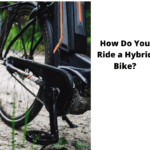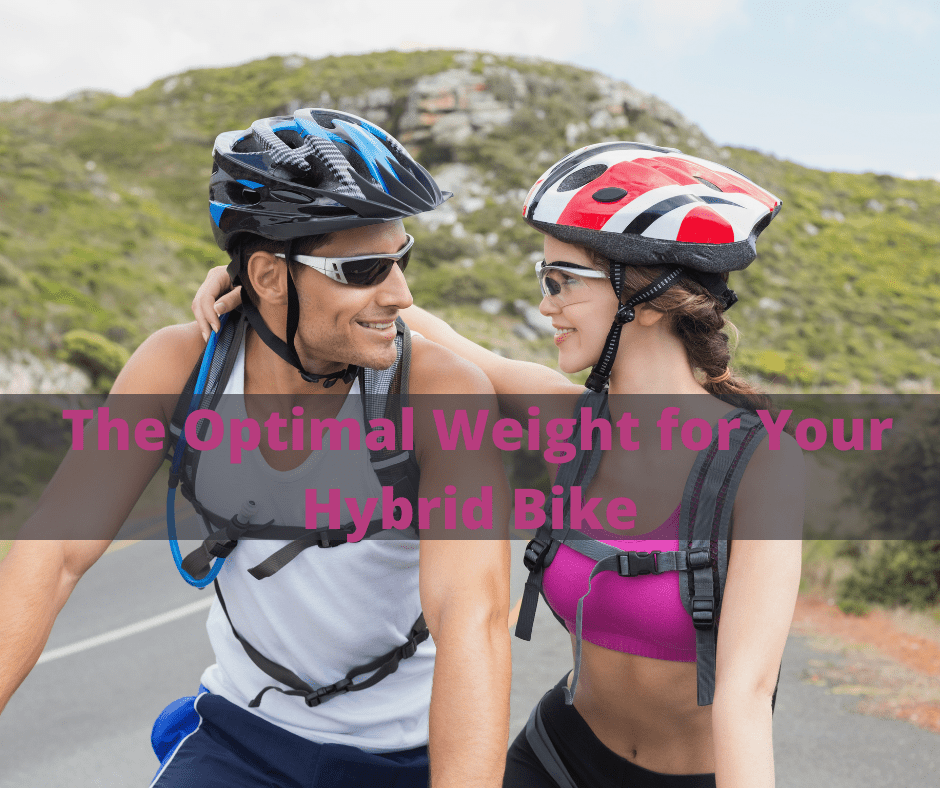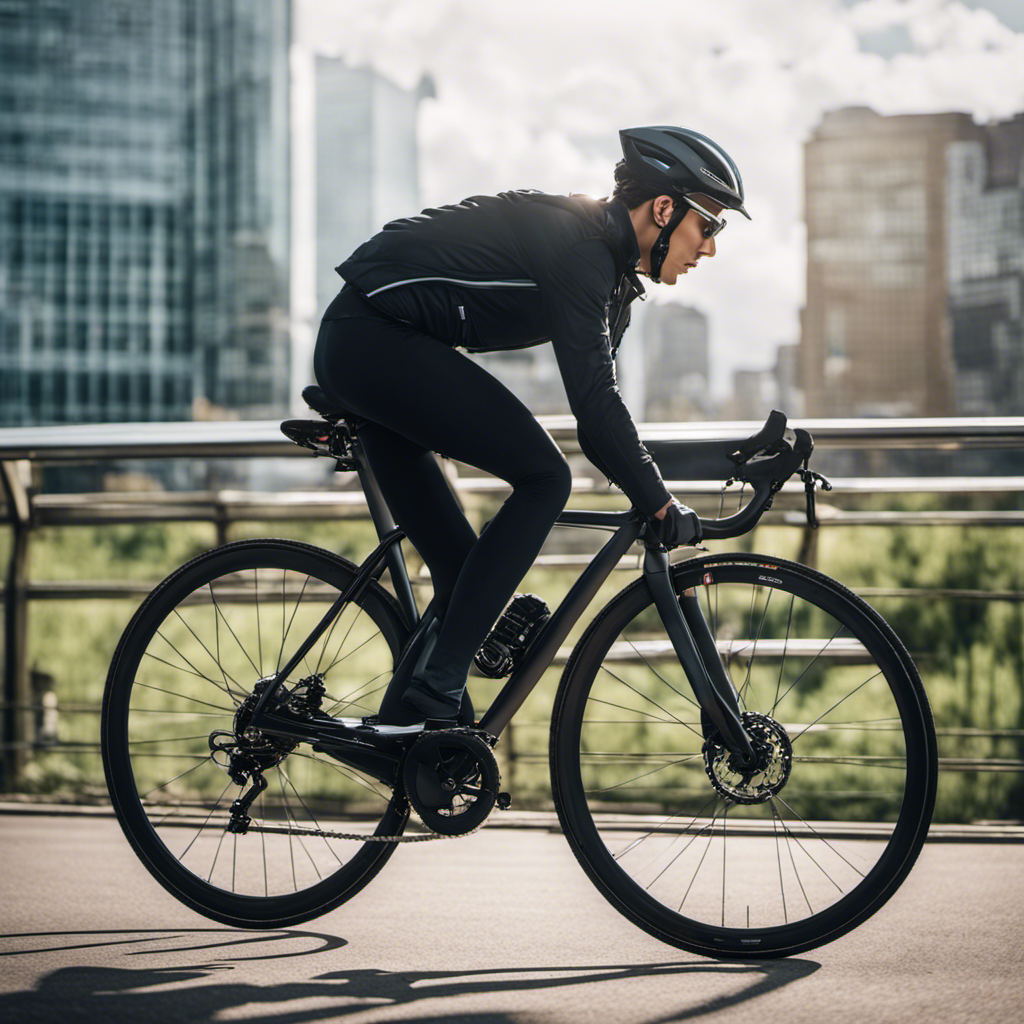As someone well-versed in hybrid bicycles, I’m eager to share with you the benefits and drawbacks associated with riding a hybrid bike.
Hybrid bikes are incredibly popular for a variety of reasons. They offer a blend of features from mountain bikes and road bikes that make them ideal for both long-distance rides as well as everyday errands.
However, it’s important to understand the pros and cons of owning one before making your purchase. In this article, I’ll walk you through the key points to consider when choosing a hybrid bike.
What Is A Hybrid Bike?
Have you ever been out biking and found yourself wishing that you had the best of all worlds? Well, if so, then the hybrid bike is definitely for you!
It’s a combination of different types of bikes, such as those meant for commuting, racing, and off-road terrain. You don’t have to choose between one or the other when you equip yourself with a hybrid bike. The perfect blend of these three styles makes it a great choice for anyone who wants to get out there on two wheels.
The hybrid bike has been around for quite some time now and continues to be a popular choice in any bike shop. It was designed specifically with comfort in mind, making it an ideal commuting option without sacrificing performance.

The frame is lightweight but still sturdy enough to handle unpaved trails or roads with ease. Combine this with its upright riding position and multiple speed settings — plus the fact that most models come equipped with hand brakes — and it’s easy to see why the hybrid bike is becoming so popular!
A great feature about this type of bike is its versatility. Whether you’re looking for a comfortable ride while running errands around town or an off-road adventure full of hills and curves, the hybrid can do it all! From mountain trails to city streets, this multi-functioning machine has something for everyone who enjoys getting outside and exploring their surroundings.
Benefits Of A Hybrid Bike
Riding a hybrid bicycle is a great choice for commuters and riders looking for versatility. Hybrid bikes combine the best features of both mountain and road bicycles, giving riders more flexibility than either of these types of bikes alone. The hybrid’s lightweight frame and skinnier tires make it easier to go longer distances than a mountain bike, while its improved suspension system makes it better suited to handle tough terrain than a road bike.
One of the major advantages of riding a hybrid bicycle is that they can easily be adapted to suit different kinds of rides. Whether you’re going on an off-road trek or commuting to work, you can adjust your hybrid’s components to your needs. With its wider range of gears, you’ll be able to take on any terrain with ease.
Plus, hybrids typically come equipped with wider seats and handlebars, making them much more comfortable for longer rides.
Overall, riding a hybrid bike offers many benefits for all kinds of riders. It’s an incredibly versatile option that can help you get from point A to point B quickly and easily – no matter what the terrain looks like. With its combination of features from both mountain and road bikes, a hybrid bicycle provides riders with the perfect blend of performance and comfortability.
All in all, this style of bike is perfect for those looking for an enjoyable ride without sacrificing speed or maneuverability. With that being said, let’s explore some drawbacks associated with riding a hybrid bicycle.
Drawbacks Of A Hybrid Bike
While hybrid bikes have a lot of advantages, there are also some drawbacks to consider.
The most notable drawback is the fact that they usually don’t have as much suspension as other types of bikes. This can make them uncomfortable to ride, especially on rougher terrain.
Additionally, they tend to have flat handlebars and v-brakes which can be more difficult to control than other types of brakes.
Shimano components are usually used on hybrid bikes, which can be expensive and lower quality than more specialized components.
Lastly, because hybrid bikes often have thinner tires, they don’t typically provide as much traction when riding on wet or muddy surfaces.

Hybrid bikes are great for casual riders looking for an all-around bicycle that performs well in many different environments. However, it’s important to consider the potential drawbacks before buying one.
If you’re planning to do a lot of off-roading or need high performance components, a hybrid bike may not be the best choice for you.
Thicker tires with better treads might help improve traction when riding in wet or muddy conditions but will also add weight to the bike and decrease its speed and efficiency on smoother surfaces.
Knowing your needs and preferences will help you decide if a hybrid bike is right for you or if another type would serve you better in your specific situation.
Types Of Hybrid Bikes
When it comes to hybrid bikes, comfort is key! I usually recommend cruiser hybrid bikes for people looking for a relaxed riding experience.
City models are great for commuters who need to get around quickly and reliably.
Mountain hybrids are rugged and can handle tough terrain.
Folding hybrids are perfect for those who need a bike that’s easy to store and transport.
Electric hybrids are great for those who need a little extra boost on their rides.
And if you’re looking for a hybrid for gravel, cargo, tandem, track, suspension, touring, fixie, recumbent, or just general use, hybrids are the perfect option!
Comfort
When it comes to comfort, hybrid bikes are a clear winner. With the combination of flat bars, carbon frames and suspension forks, you’ll be able to go further with far less fatigue.
Plus, you can add mudguards and panniers for extra comfort and convenience when cycling. The flat bars provide an upright position allowing for greater visibility of the road ahead, whilst the carbon frame absorbs any shocks from rough surfaces or potholes. The suspension fork reduces any jolts from bumps in the road helping you stay comfortable even on longer rides.
In addition, mudguards help keep your feet dry and protected from splashes whilst riding in wet conditions, and panniers provide extra storage for items like snacks or a change of clothes. All these features together make hybrid bikes a great option for those looking for comfort while riding.
So if you’re looking for a bike that will let you go further with ease, then look no further than a hybrid bike!
Cruiser
For those seeking a laid-back approach to cycling, the cruiser hybrid bike is perfect.
Featuring a wide handlebar and an upright riding position, this type of hybrid bicycle provides great versatility for leisurely rides.
Cruisers are great for casual cyclists who just want to enjoy a comfortable ride, as they offer an easygoing and relaxed ride due to their larger frames.
Plus, the wide handlebar allows you to remain in an upright position while giving you more control over the bike.
This makes them ideal for those looking for a relaxed experience while still being able to cover some distance without any hassles.
Overall, cruisers provide a great way to cruise around town in style and comfort.
City
For those looking to navigate the city streets, a road bike hybrid might be the perfect choice.
This type of hybrid bike combines aspects of a traditional road bike with those of a more modern mountain bike. The result is a fast and agile machine that can handle the varying terrain of city streets, from cobblestones to potholes.
The geometry of this type of bike also provides an efficient ride, as it’s designed to be lightweight and responsive with its shorter stem and fork. The pros and cons must be taken into consideration when deciding on this type of hybrid bicycle; although it is fast and efficient, it may not provide the same comfort as other types.
All in all, road bike hybrids provide great maneuverability for anyone looking for an exciting urban experience.
What Are The Types Of Suspension On Hybrid Bikes?
I don’t know about you, but when I ride my hybrid bike, I’m looking for a smooth and comfortable ride while still having the ability to tackle hills and terrains. Suspension is one of the most important features when it comes to that perfect balance of comfort and performance.
Let’s dive into all the different types of suspension that are available on hybrid bikes!
Suspension forks are a common feature on hybrid bikes as you will find them on most models. They help cushion any bumps in the road and improve the overall comfort of your ride.
Disc brakes are also becoming increasingly popular in hybrid bikes because they offer more stopping power than traditional rim brakes. Wider tyres with more tread can also provide better grip and traction, so if you’re looking for an adventure ready hybrid bike then look for one with wider tyres!
The top tube on a hybrid bike usually has some sort of suspension built in too, such as elastomer or spring suspension. This helps to absorb shocks from rough terrain, making it easier to keep control of your bike over uneven surfaces.
The derailleur is also an important component when it comes to suspension, as this helps ensure that your gear changes are smooth and efficient while riding over varying terrain.
So now we have gone through all the key components involved in creating a great hybrid bike experience, let’s go further by exploring which type of hybrid bike offers the best ride?
Which Type Of Hybrid Bike Offers The Best Ride?
When it comes to hybrid bikes, comfort is key! Nothing beats the feeling of a smooth ride as you make your way across town.
Speed is also important, and depending on your needs, you can find a hybrid bike with a great balance of power and maneuverability.
Of course, you need to consider the cost and durability of the bike as well.
With the right hybrid bike, you can find the perfect combination of performance and affordability.
Comfort
When it comes to comfort, hybrid bikes offer a fantastic ride. You’ll be able to pedal further and faster thanks to their lighter weight compared to mountain or road bikes.
Plus, the added comfort of mudguards and a padded saddle make these bikes ideal for longer rides. If you’re looking for something even more luxurious, carbon fiber hybrid frames can give you an extra comfortable ride.
The carbon fiber dampens vibration from the roads, making it easier on your bones and joints. Plus, you’ll also get a smoother ride than with other types of hybrids.
All in all, when it comes to comfort and performance, hybrid bikes are hard to beat!
Speed
When it comes to speed, hybrid bikes are a great choice. They offer a light weight frame and efficient drivetrain that lets you move faster than with mountain or road bikes.
The lightweight and narrower tires of most hybrids make them great for zipping around town or out on long rides. Plus, the smoother ride with carbon fiber frames can help give you an extra edge when it comes to speed.
For even more speed, you could opt for one of the faster touring bikes which have larger tires and a more aerodynamic design – these bikes take your acceleration to the next level.
All in all, if you’re looking for a bike that offers a bit more speed than your average hybrid then look no further!
How To Choose A Hybrid Bike?
When it comes to choosing a hybrid bike, size is critical – you want one that fits your body and lifestyle.
Comfort is also key, so try a few out and find one that feels right.
Don’t forget your budget – hybrids don’t have to be expensive but you get what you pay for.
I’d recommend investing in a quality hybrid that suits your needs and fits your budget. That way you can enjoy all the advantages a hybrid bike has to offer.
Just remember, you don’t have to break the bank to get a great hybrid bike – there are plenty of great options out there.
Size
Size is a key factor to consider when choosing the perfect hybrid bike for you. When it comes to overall size, there are a few things to look out for.
Firstly, if you’re planning on carrying luggage or shopping with your bike then you’ll want to make sure the frame size can accommodate this. Dropped handlebars provide greater efficiency and an aerodynamic position when riding, but they also take up more space so bear this in mind.
Wider tires provide traction and stability, but can be bulkier than slimmer tires, making them less comfortable on smaller frames. The best way to find the right size of bike is to try before you buy – go along to a specialist bike shop and have a seat on a range of models.
Remember that if you plan on mounting accessories like lights or racks on your bike, it’s important to make sure these fit your frame too. It’s also worth considering how much recreational cycling you’ll be doing; if most of your rides will be short trips around town then a smaller frame might suit better than a larger one.
Ultimately, the size of hybrid bike you choose should reflect your planned use and preferences in terms of comfort and performance – so keep this in mind when browsing!
Comfort
When it comes to riding a hybrid bike, comfort is an important factor.
You’ll want to make sure the saddle is comfortable and that the handlebars are in a position that won’t cause strain.
If you’re planning on using your bike for long leisure rides then you should look for one with wider tires, as these can provide more cushioning and absorb shock better than slimmer tires.
Look for adjustable features like stem height so you can find the perfect fit for your body type.
Finally, if you’ve got any special requirements such as back problems or arthritis, then it’s worth talking to an expert who will be able to recommend the best bike for your needs.
Budget
When it comes to selecting the right hybrid cycle, budget is an important consideration.
You don’t have to break the bank to get a good quality bike, but you do need to be realistic about what you can afford.
If you’re on a tight budget then it’s worth checking out the range of bikes available at your local bike shop as they may have some great deals that can fit your needs.
A more versatile bike such as a hybrid will give you more bang for your buck, as it will be capable of tackling multiple terrain types with ease.
Plus, if you look after it properly, it should last for years with minimal maintenance required.
What To Look For In A Hybrid Bike?
When shopping for a hybrid bike, you’ll want to look for one that best fits your needs. Gravel and road riding are both possible on a hybrid bike, so you’ll want to find the features that make it suitable for your preferred terrain. High-end models tend to be more versatile, but come with a higher price tag.
A lightweight frame is important when looking at hybrid bikes, as it will help reduce fatigue while riding and make the bike easier to maneuver. Look for a bike that comes with at least some components made of aluminum or carbon fiber. The right combination of materials can make all the difference in terms of comfort, performance and overall ride quality.
The type and size of wheels is also an important factor to consider when shopping for a hybrid bike. If you plan on doing more gravel or off-road riding, then wider tires with more tread will provide better grip over rough terrain. On the other hand, if you plan on spending more time on paved roads then narrower tires with less tread are better suited for speed and efficiency.
No matter what kind of riding you plan on doing, finding the right hybrid bike is essential for enjoying your ride and getting the most out of it. With so many different models available, there’s sure to be one that meets your needs in terms of features and price range.
Now that you know what to look for in a hybrid bike, it’s time to decide which one is best for commuting?
What Is The Best Hybrid Bike For Commuting?
When it comes to hybrid bikes, there is no one-size-fits-all solution. Each rider has different needs and preferences when it comes to choosing the right bike for them.
The advantages and disadvantages of a hybrid bike will depend on what you are looking for in terms of performance, comfort, and your overall cycling goals.
On the plus side, hybrid bikes offer riders a great combination of features from both mountain bikes and road bikes. They have wider tires than road bikes that offer more traction and stability on various terrain types. These larger tires also provide a smoother ride over rougher surfaces like pavement or gravel.
Hybrid bikes have flat handlebars like mountain bikes, which allow riders to maintain an upright riding position while still having the ability to lean forward when needed for better aerodynamics on longer rides. Additionally, many hybrid models come with front suspension that helps soak up bumps in the road and make for a smoother ride overall.
Overall, hybrid bikes are an excellent option for commuters who want the versatility of a mountain bike with the speed of a road bike. They are able to handle multiple terrains while still being lightweight enough for longer rides or commuting distances.
When selecting the best hybrid bike for commuting, be sure to consider factors such as frame size, wheel size, gears, brakes, and components so you can find one that meets your individual needs and preferences.
What Is The Best Hybrid Bike For Long Rides?
When it comes to choosing the best hybrid bike for long rides, you have a few options. If you’re looking for something that can handle both on-road and off-road surfaces, then a mountain bike with a hybrid frame is an ideal choice. It gives you the comfort and control of an on-road bike, with the durability and ruggedness of a mountain bike.
You’ll also want to make sure your hybrid bike has the right gear ratio to suit your riding style. A lower gear ratio will give you more power when climbing hills or tackling off-road terrain, while higher gears are better suited to flat roads or longer distances.
When selecting a hybrid bike for long rides, it’s important to choose one that fits your body size and riding style. Look for features such as suspension forks, adjustable handlebars and seatposts, comfortable saddles and ergonomic grips. These all contribute to making your ride more comfortable and enjoyable – particularly when covering large distances in difficult terrain.
It’s also worth investing in some accessories like mudguards, lights and panniers which will help enhance your cycling experience.
For those who are looking for an all-round machine that can take them from urban commutes to off-road adventures, there’s no better option than a hybrid bike. With its versatile frame design and range of gears, it’s well equipped for tackling any journey – no matter how long or tough it may be!
What Is The Best Hybrid Bike For Touring?
When it comes to hybrid bikes, touring is a popular style of riding. Touring is the perfect way to explore nature, while still being able to cover long distances. The best hybrid bike for touring combines the comfort of a mountain bike with the speed of a road bike, making it ideal for those extended trips.
As the saying goes, “Life is like a bicycle—in order to stay balanced, you must keep moving” and this applies to touring as well. Touring with a hybrid bike means that you can enjoy all-terrain cycling without worrying about having enough gears or your tires getting clogged up with mud.
When looking for the best hybrid bike for touring, be sure to check out features such as mudguards and racks so you can bring along extra gear and supplies on your journey. You’ll also want one that has an upright seating posture so you can take in all the sights around you without straining your back or neck.
A hybrid bike offers both comfort and speed, which makes it an excellent choice for those who are looking to tour on their own or with friends. Plus, it’s easy to find one that suits your needs; whether you’re looking for something light and fast or something heavy duty like an electric model made specifically for touring.
With a little bit of research, you’ll be sure to find the perfect hybrid bike for your next tour!
What Is The Best Hybrid Bike For Racing?
When it comes to understanding the best hybrid bike for racing, it can be tricky. But with a basic understanding of cycling and the different types of bikes, you will be able to make an informed decision.
A hybrid bike is a type of all-purpose bike that combines a mountain bike’s ruggedness and road bikes’ speed and comfort. It’s got larger tires than a road bike, making it more comfortable on rough terrain. It also has the higher-end component parts of a road bike, allowing cyclists to go faster and farther between stops.
Here are some benefits of riding a hybrid bike:
- Versatility – Hybrid bikes are great for all-around use, from commuting to exercise and leisure rides.
- Comfort – With its wider tires and upright design, hybrid bikes offer a comfortable ride you won’t get from other types of bicycles.
- Control – The combination of suspension forks and disc brakes gives riders greater control when they hit rough terrain or need to stop quickly in an emergency situation.
- Price – You don’t have to break the bank to purchase a quality hybrid bike – there are many models that fit any budget or preference.
Overall, if you’re looking for something that can tackle both roads and trails without compromising speed or comfort, then a hybrid is the way to go!
Transitioning now into how to take care of your hybrid bike?
How To Take Care Of A Hybrid Bike?
Taking care of a hybrid bike is key to keeping it running smoothly for years. Hybrid bikes are great for those who want a mix of the speed and efficiency of a road bike, with the comfort and stability of an urban ride. In India, hybrid bicycles come with flat tread tyres that are designed to traverse smoothly on different terrains.
It is important to clean your hybrid bike regularly to prevent corrosion and wear and tear, as well as to ensure it looks good. Make sure you inspect the brakes often – check for any visible damage or loose parts that need tightening or replacing.
Keep your chain oiled up, take it off and clean it thoroughly once in a while, and always use lube when putting it back on. To ensure that your hybrid bike lasts you long, perform regular maintenance checks such as checking the air pressure in the tyres, making sure the brake pads function properly and inspecting other components such as handlebars, stem, etc., for any signs of damage or breakage.
Taking care of your hybrid bike by following simple steps can go a long way in ensuring maximum performance from your ride. With proper maintenance and care taken, hybrid bikes can be a great way to get around town or explore trails with ease.
Pros And Cons Of Road Bikes Vs. Hybrid Bikes
Riding a hybrid bike is like taking a journey through two different worlds. It’s the perfect combination of a mountain bike and a road bike, making it the ideal choice for anyone looking to take on any terrain.
Here are some pros and cons of choosing a hybrid bike over traditional options:
Pros of Hybrid Bikes
- Versatility: Hybrid bikes come with racks, making them great for commuting, touring, or hauling cargo.
- Balance: With both mountain and road components, hybrid bikes offer an excellent balance between speed and comfort.
- Affordability: They tend to be cheaper than specialized road or mountain bikes.
Cons of Hybrid Bikes
- Weight: Due to their multiple components, they are heavier than either road or mountain bikes.
- Style: Some riders may not find the aesthetic appealing.
- Power: While they can handle varying terrains, they lack the power of specialized models.
A hybrid bike can be just what you need if you’re looking for something that fits your lifestyle—just make sure you stay safe when riding!
Safety Tips For Riding A Hybrid Bike
As a hybrid bike expert, I’m always telling my clients to make sure they are riding the right bike for their needs and abilities. There are three main types of bikes that people consider when they think of a hybrid—mountain bikes, road bikes, and touring bikes. Each bike has its own advantages and disadvantages, so it’s important to find the right one for you.
When considering which bike is best for you, here are some features to look out for:
| Feature | Mountain Bike | Road Bike | Touring Bike |
|---|---|---|---|
| Terrain | Off-Road | Paved | Any |
| Weight | Heavier | Lightest | Average |
| Speed | Slowest | Fastest | Moderate |
| Accessories | None | None | Many |
For example, mountain bikes are great for off-road terrain but are heavier than other types of bikes. On the other hand, road bikes can go faster on paved roads but do not come with mudguards or other accessories like touring bikes do. So depending on your needs and preference, you should be able to find the right type of hybrid bike for you.
No matter what type of bike you choose, it’s important to remember that safety should be your top priority when riding a hybrid. Wearing a helmet and proper clothing is essential as well as making sure your bike is in good working order before each ride. And if you’re ever unsure about something while riding, take a break and consult an expert before continuing on your journey!
Frequently Asked Questions
How Often Should A Hybrid Bike Be Serviced?
Did you know that the average hybrid bike needs to be serviced every 3-6 months?
As an expert in hybrid bikes, I recommend having your bike serviced every 4 months. This ensures your bike is running smoothly and efficiently, as well as allowing for any necessary maintenance or repairs.
During a service, mechanics will check over the frame, wheels, gears and brakes. They’ll also check tire pressure and make sure the chain is lubricated so it runs at its best.
Keep on top of your maintenance and you’ll enjoy a smooth ride every time!
Is A Hybrid Bike Suitable For All Terrain?
Absolutely! A hybrid bike is an ideal choice for any terrain, from paved roads to gravel trails.
It’s designed to provide a comfortable ride while having the ability to tackle various terrains. The combination of a flat handlebar and wide tires gives you stability and control no matter where you’re riding.
Plus, it has both mountain bike and road bike components: usually, mountain bikes have suspension and knobbier tires, while road bikes are more efficient on paved roads.
With a hybrid bike, you get the best of both worlds!
What Is The Average Cost Of A Hybrid Bike?
Hybrid bikes are a great choice for those who want to explore the roads, trails and paths in between. They are versatile and offer a smooth ride, so it’s no surprise that they come with a variety of price tags.
Generally speaking, you can expect to pay anywhere from $300-1400 for a hybrid bike depending on features like suspension, frame material and type of drivetrain. Of course, if you’re looking for something more specialized or higher quality then the cost could go even higher.
So while they may be a bit on the pricier side, hybrid bikes really do offer something for everyone – no matter your budget!
Is A Hybrid Bike Suitable For Off-Road Cycling?
A hybrid bike can definitely be suitable for off-road cycling!
As an expert on hybrid bikes, I believe they are a great option for those who want to explore nature without breaking the bank.
They provide a more comfortable ride with their upright riding position and shock absorption system.
Plus, they have wide tires that are designed to handle different terrains.
All in all, a hybrid bike is an excellent choice for anyone looking to hit the trails.
What Is The Average Weight Of A Hybrid Bike?
The average weight of a hybrid bike is often likened to the wings of a butterfly- light enough to take you places but strong enough for the journey.
On average, hybrid bikes weigh between 20 and 35 pounds, depending on the quality of components used.
High-end hybrids can be closer to 40 pounds, but this is still lighter than most mountain or road bikes.
As an expert in hybrid bikes, I find that these models offer a great combination of lightweight maneuverability and durability that make them perfect for everyday riding.
A hybrid bike has several advantages over a traditional bicycle. This bike has an upright stance, sturdy frame, wide tires, and gearing. Additionally, this bike can be used for pavement and off-road riding. The disadvantage is that these bikes are heavier than typical road bikes and do not like riding on dirt or rough terrain.
The other drawback of a hybrid bike is that it requires a little more effort to pedal than a standard road bike. The gearing and brakes are more complex, and the hybrid bike is also more expensive. Commuting on a hybrid bike will require a little more effort, but the advantages outweigh the disadvantages.
Features
While bikes have different features, a hybrid is usually designed to cater to various riding styles. Its wheels are typically 700c in size and are well-suited to riding on varied terrain. Some hybrid bikes are designed with 26-inch tires, smaller than 700c but still ideal for off-road cycling. A hybrid is also lightweight, which makes it suitable for commuting. Whether you need a bike for your commute or a weekend excursion, there is a hybrid bicycle.
Most hybrid bikes come equipped with platform pedals, which can be helpful when pedaling continuously, but more experienced riders prefer pad clips. Other features of a hybrid bike include a cyclo-computer, frame pump, water bottle, and cage. These accessories can make you more self-reliant and comfortable while riding. However, before buying a hybrid bike, you should consider the shape of the bike and its features. These bikes are not for every riding style.
Durability
Regardless of the brand name, a hybrid bike can be durable. Most high-end models have suspension forks and high-volume tires to improve comfort and traction on varied surfaces. These bikes can handle a variety of terrain and can be used on different surfaces and landscapes, including pavement, dirt, and even snow. This feature helps them last longer than conventional bikes. Each hybrid type has advantages and disadvantages, but it is essential to consider what you’ll be using your bike for.
If you plan to use your hybrid bike for commuting or for work, make sure it has all the necessary safety features. Some bikes have integrated lights, fenders, and racks to carry items. However, they tend to cost more and may not suit your needs for a fun ride. If you’re shopping for a gift for someone special, make sure that the model you choose is durable enough to withstand the recipient’s demands.
Price
The price of a hybrid bike is a great thing to consider if you’re looking to purchase one for yourself. A hybrid is a way to go if you want a fun, fast ride. These bikes are lightweight and comfortable, making them easy to maneuver and ride on various terrains. You can expect the ride quality to be good, too. And because they’re lightweight, they’re also easy to steal, making them great for urban areas.
While hybrid bikes do not have the same top speed as road bike, they will be able to tackle a few fierce hills. It’s important to keep in mind that a hybrid bike will have road-derived gearing, so heavier riders will struggle with gearing. A hybrid bike with a higher gear ratio may not be the right choice if you’ll be riding on rough terrain. This can be a problem, so make sure you choose a bike that is tougher than your current one.
Conclusion
As an expert in hybrid bikes, I believe they are a great choice for any cyclist. They offer a wonderful blend of the speed and responsiveness of a road bike, with the ruggedness of a mountain bike. Hybrid bikes can be used on a variety of terrain including roads, trails, and more challenging off-road courses. In addition to their versatility, they are also relatively affordable compared to other types of bicycles.
From my experience as a frequent rider, I can say with confidence that hybrid bikes have few drawbacks. The only thing you need to consider is scheduling regular maintenance so that your bike stays in top condition for years to come.
So if you’re looking for an all-around cycling solution that offers plenty of fun and excitement, then look no further than the hybrid bike!
















